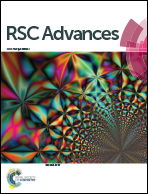Improved oxygen reduction reaction activity of three-dimensional porous N-doped graphene from a soft-template synthesis strategy in microbial fuel cells†
Abstract
Electrocatalysts with high oxygen reduction reaction (ORR) activity are still of great significance to improve the performance of microbial fuel cells (MFCs). We report herein an approach to synthesize three-dimensional porous nitrogen-doped graphene (PNG) using cetyltrimethyl ammonium bromide (CTAB) micelles as soft templates. Based on this strategy, one type of PNG series, denoted PNG-15, is obtained by optimizing the mass ratios of CTAB and GO. This material exhibits a well-developed porous structure with a high surface area of 615.2 m2 g−1. The results of XRD, Raman spectroscopy, and XPS analyses verify that the superior porous structure of PNG-15 is beneficial to the formation of active centers. Therefore, this material shows an ORR electron transfer number of 3.88 ± 0.10 in a neutral medium and comparable activity to commercial Pt/C. Such comparable performance of PNG-15 is preserved as a cathode electrocatalyst in MFCs in terms of voltage output, coulombic efficiency, and power density output. Furthermore, the PNG-15 demonstrates superior long-time stability to Pt/C during over two-months of operation. The findings confirm that the new material can serve as a promising cathode electrocatalyst in MFCs.


 Please wait while we load your content...
Please wait while we load your content...